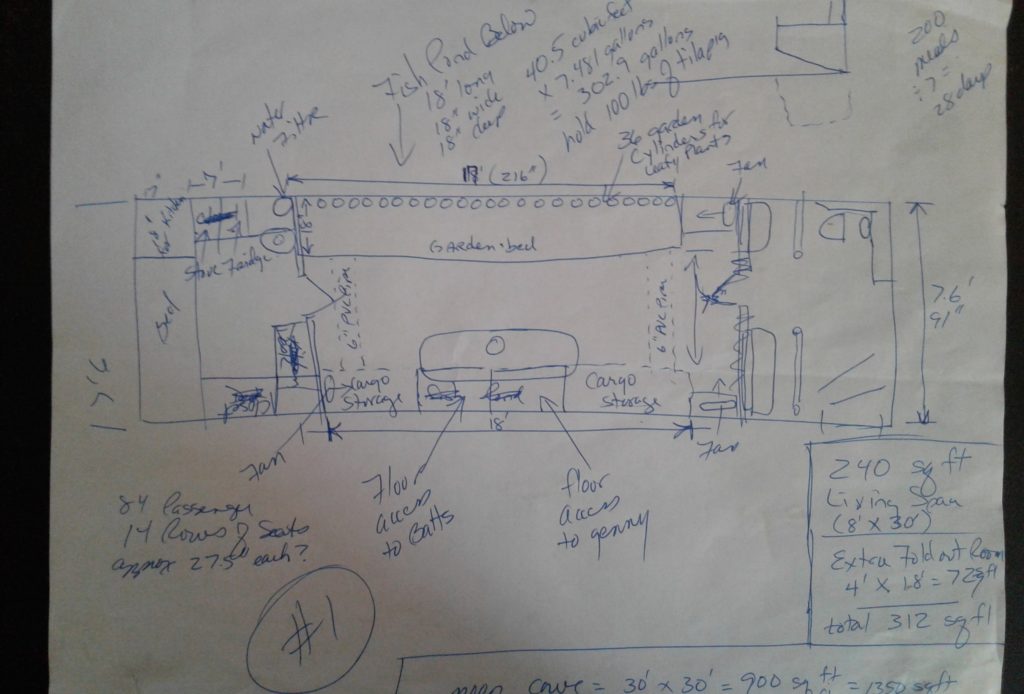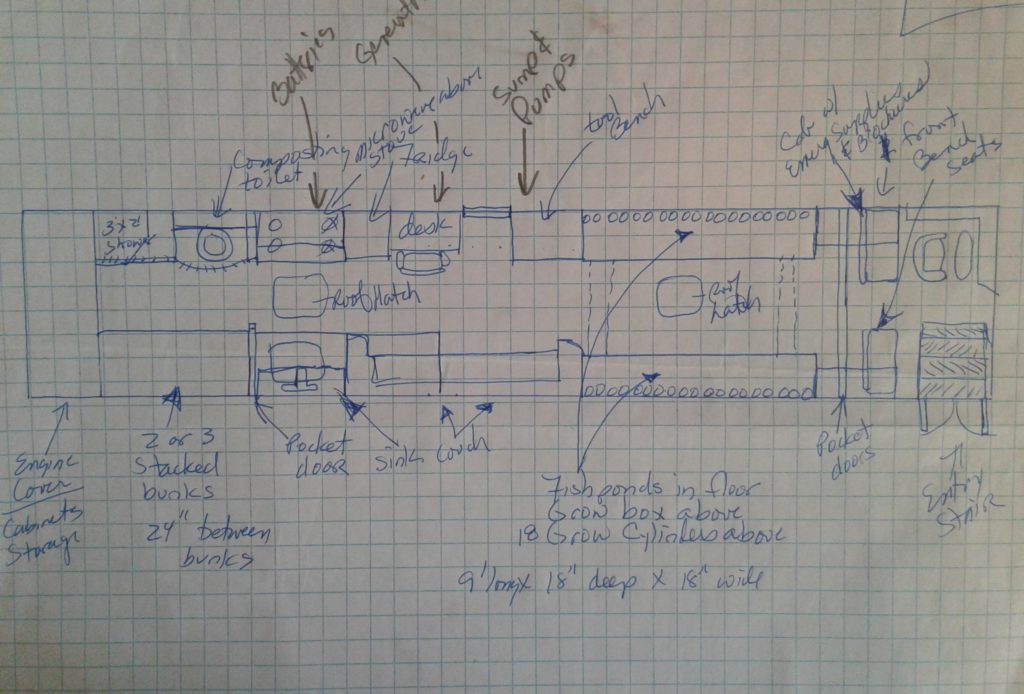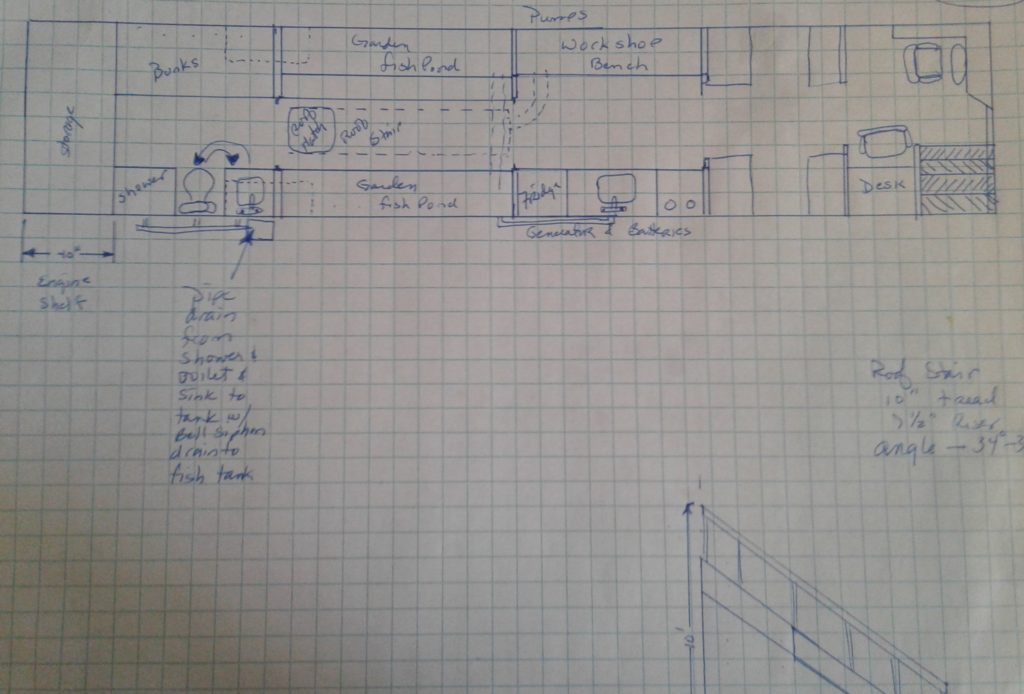One of the challenges of any project is defining a plan to follow. Often I have had the luxury of carying my plan in my head, with a modicum of success. However this project is far to big to attempt any such thing. As a result, a couple days ago, I took measurements of the interior in order to prepare a floor plan. The result: I’ve got about 30 feet long and 7.5 feet wide of floor space to work with. That does not include the front driver area, and the back area over the engine.
At first, I wanted to keep things simple, by building the fish pond and garden on one side of the bus. However, I realized that a more compact arrangement would be more efficient, despite the plumbing being slightly more difficult. Being able to close off the area to facilitate air, light, and handling is a good thing. So I went through a couple more iterations …
Now, with the pond and garden at the front of the bus, the entire rear 2/3’s becomes living space. I even considered cross-over pipes under the floor to link the two tanks. Attractive as this is, then, when I crawled under the bus to investigate, I discovered that the fuel tank sits centered under the floor directly below the area that would facilitate the cross-overs. Oops. Back to the drawing board.
So, after this time, I’m on my fifth floor plan. The pond/garden is shifted to a center point, splitting the living space. The bunks and bathroom have swapped sides, as I found a heater mounted to the floor on the left side just rear of the wheel well. Note that all the plumbing fixtures are located on the right/passenger side. This will make it easier … I hope.
For the time being, this will be the plan I follow. Given that the requirements to qualify as an RV center around plumbing, power, and a bunk. That means I’ll be starting construction in the rear.
Details: Plumbing
The shower, then sink, then toilet will be built approximately 6″ above the floor to facilitate drainage beneath them all the way to the pond. Water from the shower and sink will collect under the toilet as a means of diluting urine collected. Then a bell siphon under the toilet will release a “full dilution” directly into the fish pond. The same will be true under the kitchen sink. A reservoir with a bell siphon will catch water from the sink, and then periodically drain into the pond.
Fresh water tanks (hot and cold) will be suspended from the ceiling next to the right/passenger walls. This will facilitate gravity feed to the two sinks, limiting power requirements. A small demand-pump will be used for the shower.
Details: Power
The RV requirements detail the need for an electrical power source not from the engine. I already have acquired a 4kw gas generator as the qualifying component, will be mounted beneath the floor of the shower. Wiring will be routed via EMT conduit to a distribution panel in the kitchen area. Still deciding how to best distribute the circuits, as the pumps will be mounted under the floor with the fish pond, and I will need some power for the workshop bench and it’s tools.
Details: Sleeping
Sleeping arrangements will be submarine style: stacked compact bunks. So far, planning on two bunks along the wall, but exploring stacking three along the wall, and maybe a fourth over the engine. Once I get started on the bunks, I’ll get a better feel for the spacing.
A Word About Wastes
This bus is intended to demonstrate how we will live on the Moon, Mars, or even further out. As shown in the film The Martian, wastes are valuable resources. Therefore, the design of the living space will include their recycling.
While I described urine catch in the section on Plumbing above, solid wastes (food and feces) will be placed in the toilet itself. There insects, Black Soldier Fly larvae, and Red Wiggler worms will consume the wastes, and convert them to compost.
In addition, some fibrous food/garden wastes will be used as feeder material for mycellium, and perhaps algae.
Summary
It isn’t enough to plan for air and food production, we must be able to complete the cycle for wastes within this biome. Without waste processing and recycling, the other components simply will fail over time. The entire bus will be organized around life … not leisure. For it is Life that will take us to space atop our rockets.


